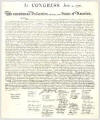|
 
13 COLONIES READY TO RULE THEMSELVES
Declaration of Independence 1776
The Continental Congress (definition
below) passed the U.S. Declaration of Independence on July 4, 1776.
By means of this document, 13 British colonies in North America
declared their independence from Great Britain. The 13 colonies, now
states, were: Connecticut, Delaware, Georgia, Massachusetts,
Maryland, New York, New Jersey, New Hampshire, North Carolina,
Pennsylvania, Rhode Island, South Carolina, and Virginia.
 READ HERE THE FULL TRANSCRIPT OF THE DECLARATION
READ HERE THE FULL TRANSCRIPT OF THE DECLARATION
WHAT WAS THE CONTINENTAL CONGRESS?
According to Princeton's WordNet, the
Continental Congress
was
"the legislative assembly composed of delegates from the rebel
colonies who met during and after the American Revolution; they
issued the Declaration of Independence and framed Articles of
Confederation."
In the U.S., the 4th of July is annually celebrated as Independence Day.
Here you can
 download a high resolution image of the Declaration of Independence.
download a high resolution image of the Declaration of Independence.
For those of you who get a turn on from
paper work: Here you can
 download the Declaration of Independence as wallpaper.
download the Declaration of Independence as wallpaper.
THE PICTURES AT THE TOP OF THE PAGE
The
 National
Archives and Records Administration explains:
National
Archives and Records Administration explains:
"The image of the Declaration
[to the left]
is taken from the engraving made by printer William J. Stone in 1823
and is the most frequently reproduced version of the document. The
original Declaration [pictured to the right], now exhibited in the
Rotunda for the Charters of Freedom in Washington, DC, has faded
badly — largely because of poor preservation techniques during the
19th century. Today, this priceless document is maintained under the
most exacting archival conditions possible."
UNITED STATES OF
AMERICA FOR THE FIRST TIME
The first known use of the formal term "United States of America"
was in the Declaration of Independence.
See also
 American Timeline.
American Timeline.
And with regards to French support for
the American revolutionaries and against the British see also
 Vergennes.
Vergennes.
More History
|